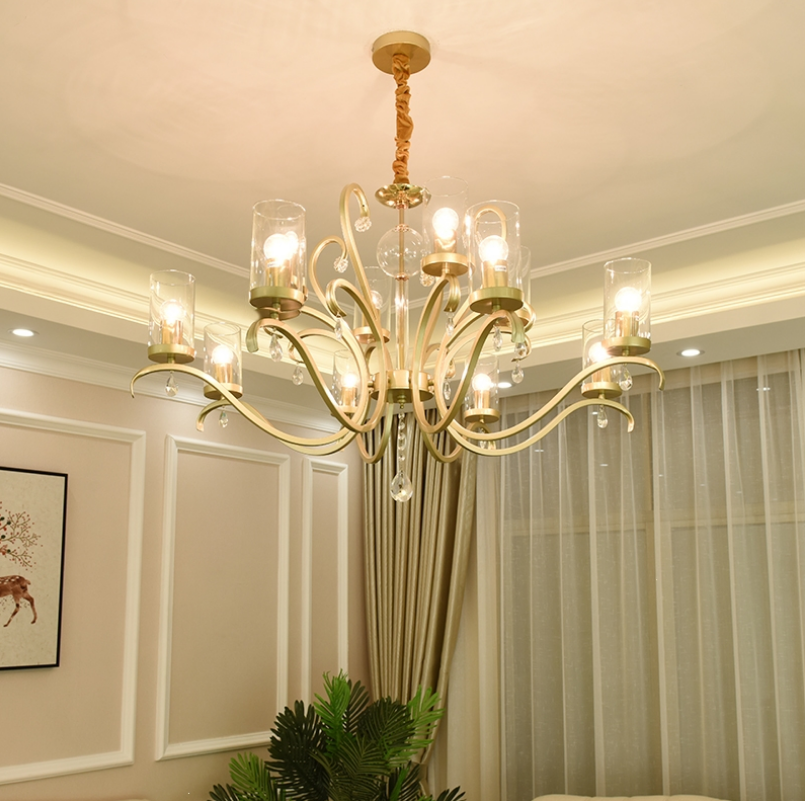The history of crystal chandeliers is a fascinating journey that intertwines art, craftsmanship, and the evolution of interior design. Originating in the medieval period, chandeliers were initially simple wooden frames adorned with candles. These early designs were functional, providing light in dark spaces, but they also began to take on a decorative role as they became more elaborate.
By the 16th century, the use of glass in chandelier Yigolighting design emerged, particularly in Venice, where artisans began to create intricate glass pieces that reflected light beautifully. This marked the beginning of the transition from utilitarian lighting to a symbol of luxury and opulence. As the centuries progressed, crystal chandeliers became synonymous with wealth and status.
The introduction of lead crystal in the 18th century revolutionized chandelier design, allowing for more intricate cuts and shapes that enhanced the refractive qualities of glass. Notable examples include the grand chandeliers found in palaces and cathedrals across Europe, such as the Hall of Mirrors in the Palace of Versailles. These magnificent structures not only illuminated vast spaces but also served as focal points that showcased the artistry of their makers.
The craftsmanship involved in creating these chandeliers was immense, often requiring skilled artisans to hand-cut and polish each crystal piece, resulting in stunning works of art that have stood the test of time.
Choosing the Perfect Crystal Chandelier for Your Living Room
Selecting the ideal crystal chandelier for your living room involves a careful consideration of various factors, including size, style, and the overall aesthetic of the space. One of the first steps is to assess the dimensions of your living room. A chandelier that is too large can overwhelm a small space, while one that is too small may get lost in a larger room.
A general guideline is to add the length and width of the room in feet; this total in inches will give you a good estimate of the diameter of the chandelier you should consider. For instance, if your living room measures 12 feet by 15 feet, a chandelier with a diameter of around 27 inches would be appropriate. Beyond size, the style of the chandelier should complement your existing décor.
Crystal chandeliers come in a variety of designs, from traditional to contemporary. If your living room features classic furnishings and rich fabrics, a traditional chandelier with ornate detailing and cascading crystals may be ideal. Conversely, if your space leans towards modern minimalism, consider a sleek design with clean lines and fewer embellishments.
Additionally, think about the color palette of your living room; clear crystals can enhance light and create an airy feel, while colored crystals can add a unique touch and serve as a statement piece.
The Impact of Crystal Chandeliers on Living Room Décor
Crystal chandeliers have a profound impact on living room décor, serving as both functional lighting and striking artistic elements. Their ability to refract light creates an enchanting ambiance that can transform a space from ordinary to extraordinary. When strategically placed, a crystal chandelier can draw attention to specific areas within the room, such as seating arrangements or artwork.
The interplay of light and shadow produced by the crystals can add depth and dimension to your living space, making it feel more inviting and luxurious. Moreover, crystal chandeliers can serve as conversation starters and focal points within your living room. A well-chosen chandelier can reflect your personal style and taste, making it an integral part of your home’s identity.
For example, a vintage crystal chandelier can evoke nostalgia and charm, while a modern piece might convey sophistication and contemporary flair. The visual weight of a chandelier can also influence how other elements in the room are perceived; it can balance heavier furniture or elaborate wall treatments, creating a harmonious overall design.
Maintenance and Cleaning Tips for Living Room Crystal Chandeliers
Maintaining the beauty of your crystal chandelier requires regular cleaning and care to ensure it remains sparkling and free from dust and grime. Dust accumulation can dull the brilliance of the crystals over time, so it’s essential to establish a cleaning routine. A gentle approach is recommended; using a soft feather duster or microfiber cloth can effectively remove surface dust without scratching the crystals.
For more thorough cleaning, consider using a solution of warm water mixed with a few drops of mild dish soap. Dampen a cloth with this solution and carefully wipe each crystal, taking care not to let any moisture seep into electrical components. In addition to regular dusting and cleaning, it’s important to periodically check for loose crystals or fittings.
Over time, vibrations from daily activities or changes in temperature can cause components to loosen. If you notice any issues, it’s advisable to address them promptly to prevent further damage. For more complex maintenance tasks or repairs, consulting with a professional who specializes in chandelier restoration can ensure that your fixture remains in optimal condition.
How to Incorporate Modern Technology with Traditional Crystal Chandeliers
The integration of modern technology into traditional crystal chandeliers has opened up new possibilities for enhancing their functionality while preserving their classic beauty. One popular trend is the incorporation of LED lighting into chandelier designs. LED bulbs are energy-efficient and have a longer lifespan compared to traditional incandescent bulbs, making them an attractive option for homeowners looking to reduce energy consumption without sacrificing style.
Many modern LED bulbs are designed to mimic the warm glow of traditional lighting, ensuring that the ambiance remains inviting. Smart home technology also offers exciting opportunities for crystal chandeliers. With advancements in home automation systems, homeowners can now control their lighting remotely through smartphones or voice-activated devices.
Dimming capabilities allow for customizable lighting levels depending on the occasion—whether it’s an intimate dinner party or a lively gathering with friends. Additionally, some smart chandeliers come equipped with color-changing features that enable users to adjust the hue of their lighting to match their mood or décor theme seamlessly.
The Different Styles and Designs of Living Room Crystal Chandeliers
Traditional Elegance
Traditional crystal chandeliers often feature intricate detailing with cascading crystals arranged in elaborate patterns. These chandeliers may include ornate metalwork, such as wrought iron or brass finishes, which enhance their vintage appeal.
Classic Inspirations
Classic styles often draw inspiration from historical periods like Baroque or Rococo, characterized by their grandeur and opulence. In contrast, contemporary crystal chandeliers embrace minimalism and sleek lines while still showcasing the beauty of crystal elements.
Modern Twists
Some modern interpretations even blend materials such as wood or metal with crystal accents, resulting in unique pieces that bridge traditional elegance with contemporary flair. Whether you prefer a timeless classic or a cutting-edge design, there is a crystal chandelier that can perfectly complement your living room.
The Importance of Proper Installation and Placement of Crystal Chandeliers
Proper installation and placement are crucial for maximizing both the aesthetic appeal and functionality of crystal chandeliers in your living room. When installing a chandelier, it’s essential to consider ceiling height; a general rule is to hang the fixture approximately 30 to 36 inches above dining tables or surfaces where people will gather. In living rooms with higher ceilings, you may opt for a larger chandelier that draws the eye upward while maintaining appropriate clearance for movement beneath it.
Placement also plays a significant role in how effectively a chandelier illuminates the space. Ideally, it should be positioned centrally within the room or above key focal points such as seating areas or coffee tables. This strategic placement ensures that light is distributed evenly throughout the space while enhancing visual interest.
Additionally, considering other light sources within the room—such as floor lamps or wall sconces—can help create layers of illumination that contribute to an inviting atmosphere.
The Timeless Appeal of Crystal Chandeliers in Living Room Design
The enduring allure of crystal chandeliers lies in their ability to transcend trends and remain relevant across various design eras. Their timeless elegance makes them suitable for both traditional and modern interiors alike. As design preferences evolve, crystal chandeliers continue to adapt while retaining their core characteristics—beauty, craftsmanship, and sophistication.
This versatility allows them to seamlessly integrate into diverse settings, from grand ballrooms to cozy living rooms. Furthermore, crystal chandeliers evoke a sense of nostalgia and romance that resonates with many homeowners. They serve as reminders of opulent pasts while offering contemporary functionality through modern innovations.
This duality enhances their appeal; they are not merely decorative fixtures but also symbols of artistry and heritage that enrich living spaces with character and charm. As long as there are homes seeking beauty and elegance, crystal chandeliers will undoubtedly remain cherished elements in living room design.

